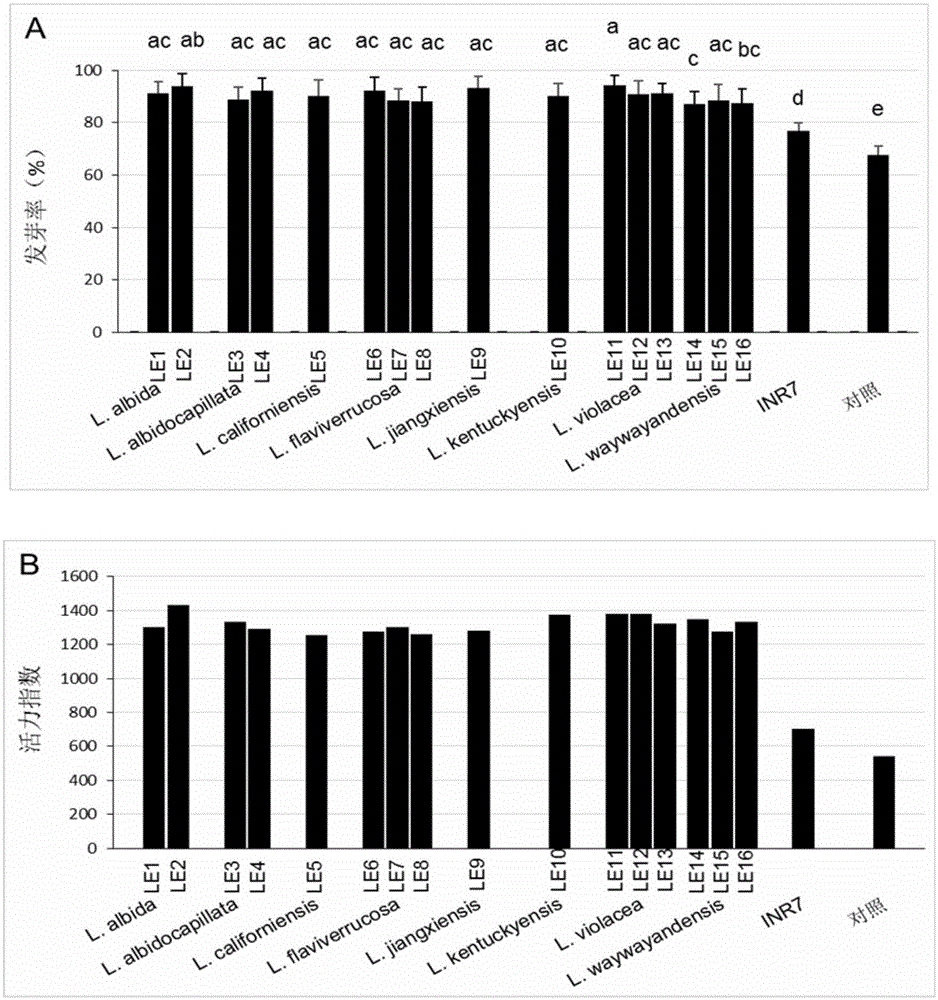Application of five plant growth-promoting rhizobacteria to improvement of agronomic traits of plants
A technology for rhizosphere growth-promoting bacteria and agronomic traits, applied in the field of biotechnology and breeding, can solve the problems of difficult to be recognized by consumers, not obvious effect, difficult to popularize and apply, etc.
- Summary
- Abstract
- Description
- Claims
- Application Information
AI Technical Summary
Problems solved by technology
Method used
Image
Examples
Embodiment 1
[0122] Example 1 Determination of beneficial bacteria for promoting plant growth and development
[0123] Soil samples were collected from the millet test field in Yangling Agricultural High-tech Industrial Demonstration Park (34°16′18″N / 108°4′59″E), Shaanxi Province. When the millet was harvested, 3 millets of each line were randomly selected, and Bulgarelli et al. (2012) (Bulgarelli, D., Rott, M., Schlaeppi, K., van Themaat, E.V.L., Ahmadinejad, N., Assenza, F. ,...&Schulze-Lefert, P. (2012). Revealing structure and assembly cues for Arabidopsis root-inhabiting bacterial microbiota. Nature, 488(7409), 91-95.) The method described in collecting rhizosphere soils. Meanwhile, take 10 parts of soil in an unplanted plot. Put the collected soil samples into sterilized collection tubes, freeze them on dry ice and transport them to Shenzhen Huada Gene Research Institute, and store them in a -20°C low-temperature refrigerator for later use.
[0124] Take 0.2 g of each sample for ge...
Embodiment 2
[0130] Embodiment 2 selects bacterial strain, prepares agricultural preparation
[0131] 2.1 Source of strain
[0132] According to the genus information obtained in Example 1 of the present invention, the inventor BLAST compares the 16S rRNA gene sequences of multiple strains of yellow soil-derived bacteria with OUT255, and the comparison results are shown in Table 1; the 16S rRNA gene sequences of multiple strains of Ferruginibacter bacteria Perform BLAST comparison with OTU5352, and the comparison results are shown in Table 2; BLAST comparison of the 16S rRNA gene sequences of multiple strains of Rendzella with OTU1892, and the comparison results are shown in Table 3; The rRNA gene sequence was compared with OTU414 by BLAST, and the comparison results were shown in Table 4;
[0133] Table 1 BLAST comparison results of OTU255 sequence and 16S rRNA gene partial sequences of four yellow soil-derived bacteria
[0134]
[0135]
[0136] Table 2 BLAST comparison results o...
Embodiment 3
[0175] Example 3 Effects of five rhizosphere growth-promoting bacteria on millet germination under laboratory conditions
[0176] experimental method:
[0177] 3.1 Seed Treatment
[0178] Millet seeds were surface sterilized with 1% sodium hypochlorite for 5 minutes and rinsed 5 times with sterile distilled water. Using 1% carboxymethyl cellulose as an adhesive to coat the seed coat, the ingredients of the seed coat are Flavisolibacter, Ferruginibacter, Lentzea, Solirubrobacter, Terrimonas, or a combination thereof, and a mixture of peat (Biocare Technology Pvt., Australia) (bacteria content of 10 8 -10 9 CFU / g peat) and then air-dried. 10 bacteria per seed 6 -10 7 CFU. Control seeds were wrapped with non-bacterial peat.
[0179] 3.2 In vitro growth promotion test
[0180] Bacterial-treated and control seeds were sown onto paper towels. Soak paper towels in distilled water and place 50 seeds evenly on each paper towel. Then cover it with another damp paper towel to ...
PUM
 Login to View More
Login to View More Abstract
Description
Claims
Application Information
 Login to View More
Login to View More - R&D
- Intellectual Property
- Life Sciences
- Materials
- Tech Scout
- Unparalleled Data Quality
- Higher Quality Content
- 60% Fewer Hallucinations
Browse by: Latest US Patents, China's latest patents, Technical Efficacy Thesaurus, Application Domain, Technology Topic, Popular Technical Reports.
© 2025 PatSnap. All rights reserved.Legal|Privacy policy|Modern Slavery Act Transparency Statement|Sitemap|About US| Contact US: help@patsnap.com



